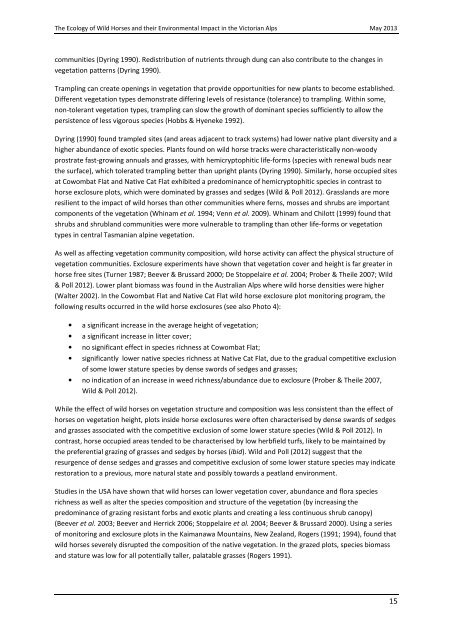The Ecology of Wild Horses and their Environmental ... - Parks Victoria
The Ecology of Wild Horses and their Environmental ... - Parks Victoria
The Ecology of Wild Horses and their Environmental ... - Parks Victoria
You also want an ePaper? Increase the reach of your titles
YUMPU automatically turns print PDFs into web optimized ePapers that Google loves.
<strong>The</strong> <strong>Ecology</strong> <strong>of</strong> <strong>Wild</strong> <strong>Horses</strong> <strong>and</strong> <strong>their</strong> <strong>Environmental</strong> Impact in the <strong>Victoria</strong>n Alps May 2013communities (Dyring 1990). Redistribution <strong>of</strong> nutrients through dung can also contribute to the changes invegetation patterns (Dyring 1990).Trampling can create openings in vegetation that provide opportunities for new plants to become established.Different vegetation types demonstrate differing levels <strong>of</strong> resistance (tolerance) to trampling. Within some,non-tolerant vegetation types, trampling can slow the growth <strong>of</strong> dominant species sufficiently to allow thepersistence <strong>of</strong> less vigorous species (Hobbs & Hyeneke 1992).Dyring (1990) found trampled sites (<strong>and</strong> areas adjacent to track systems) had lower native plant diversity <strong>and</strong> ahigher abundance <strong>of</strong> exotic species. Plants found on wild horse tracks were characteristically non-woodyprostrate fast-growing annuals <strong>and</strong> grasses, with hemicryptophitic life-forms (species with renewal buds nearthe surface), which tolerated trampling better than upright plants (Dyring 1990). Similarly, horse occupied sitesat Cowombat Flat <strong>and</strong> Native Cat Flat exhibited a predominance <strong>of</strong> hemicryptophitic species in contrast tohorse exclosure plots, which were dominated by grasses <strong>and</strong> sedges (<strong>Wild</strong> & Poll 2012). Grassl<strong>and</strong>s are moreresilient to the impact <strong>of</strong> wild horses than other communities where ferns, mosses <strong>and</strong> shrubs are importantcomponents <strong>of</strong> the vegetation (Whinam et al. 1994; Venn et al. 2009). Whinam <strong>and</strong> Chilott (1999) found thatshrubs <strong>and</strong> shrubl<strong>and</strong> communities were more vulnerable to trampling than other life-forms or vegetationtypes in central Tasmanian alpine vegetation.As well as affecting vegetation community composition, wild horse activity can affect the physical structure <strong>of</strong>vegetation communities. Exclosure experiments have shown that vegetation cover <strong>and</strong> height is far greater inhorse free sites (Turner 1987; Beever & Brussard 2000; De Stoppelaire et al. 2004; Prober & <strong>The</strong>ile 2007; <strong>Wild</strong>& Poll 2012). Lower plant biomass was found in the Australian Alps where wild horse densities were higher(Walter 2002). In the Cowombat Flat <strong>and</strong> Native Cat Flat wild horse exclosure plot monitoring program, thefollowing results occurred in the wild horse exclosures (see also Photo 4):• a significant increase in the average height <strong>of</strong> vegetation;• a significant increase in litter cover;• no significant effect in species richness at Cowombat Flat;• significantly lower native species richness at Native Cat Flat, due to the gradual competitive exclusion<strong>of</strong> some lower stature species by dense swords <strong>of</strong> sedges <strong>and</strong> grasses;• no indication <strong>of</strong> an increase in weed richness/abundance due to exclosure (Prober & <strong>The</strong>ile 2007,<strong>Wild</strong> & Poll 2012).While the effect <strong>of</strong> wild horses on vegetation structure <strong>and</strong> composition was less consistent than the effect <strong>of</strong>horses on vegetation height, plots inside horse exclosures were <strong>of</strong>ten characterised by dense swards <strong>of</strong> sedges<strong>and</strong> grasses associated with the competitive exclusion <strong>of</strong> some lower stature species (<strong>Wild</strong> & Poll 2012). Incontrast, horse occupied areas tended to be characterised by low herbfield turfs, likely to be maintained bythe preferential grazing <strong>of</strong> grasses <strong>and</strong> sedges by horses (ibid). <strong>Wild</strong> <strong>and</strong> Poll (2012) suggest that theresurgence <strong>of</strong> dense sedges <strong>and</strong> grasses <strong>and</strong> competitive exclusion <strong>of</strong> some lower stature species may indicaterestoration to a previous, more natural state <strong>and</strong> possibly towards a peatl<strong>and</strong> environment.Studies in the USA have shown that wild horses can lower vegetation cover, abundance <strong>and</strong> flora speciesrichness as well as alter the species composition <strong>and</strong> structure <strong>of</strong> the vegetation (by increasing thepredominance <strong>of</strong> grazing resistant forbs <strong>and</strong> exotic plants <strong>and</strong> creating a less continuous shrub canopy)(Beever et al. 2003; Beever <strong>and</strong> Herrick 2006; Stoppelaire et al. 2004; Beever & Brussard 2000). Using a series<strong>of</strong> monitoring <strong>and</strong> exclosure plots in the Kaimanawa Mountains, New Zeal<strong>and</strong>, Rogers (1991; 1994), found thatwild horses severely disrupted the composition <strong>of</strong> the native vegetation. In the grazed plots, species biomass<strong>and</strong> stature was low for all potentially taller, palatable grasses (Rogers 1991).15
















